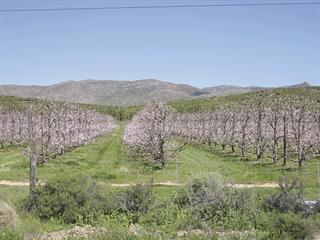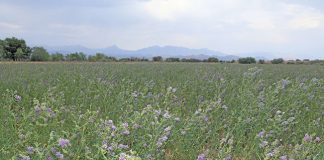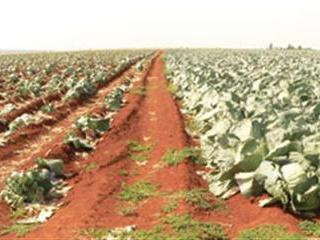
Weeds have a bad reputation, but this is often undeserved, says Graeme Sait, an Australian expert on high-production sustainable agriculture and CEO of Nutritech Solutions. Yes, they can reduce crop yields and quality, harbour pests and diseases, taint milk, contaminate wool and poison livestock. But they can also colonise bare soil and prevent erosion, loosen up hard soil and transport nutrients from the sub-soil. Their role in scavenging and conserving nutrients such as nitrogen and sulfur, which might otherwise leach away, is often ignored. So is their role in providing shelter and food for native insects.
Some weeds have nutritional and medicinal value. Dandelions, for example, have higher protein levels than lucerne, comparable mineral content and almost double the relative feed value. Graeme Sait recently spoke to 130 farmers in Paarl and Bloemfontein about integrated weed management. In the group were several Woolworths producers who participate in the chain’s Farming for the Future initiative. Graeme quotes Dr Arden Anderson, a soil scientist and agricultural consultant who is also a physician and an expert on the link between soil and human health.
“Dr Anderson says each weed species is genetically keyed to replace a specific deficiency,” he says. “If weeds correct the imbalance of minerals, the greater the imbalance, the better the weed growth.” “Instead of seeing weeds as a problem, think of them as a symptom of problem soil.” Many weeds will only germinate in very poor soil conditions. It’s flocculated, well-drained soil with a good crumb structure that generally promotes crop growth.
Know your weeds
Nutrient balance in the soil is vital to discourage weed growth – and farmers can evaluate what’s wrong with their soils by identifying the weeds present.“Sandy, alkaline and badly drained soils each produce different groups of weeds,” explains Graeme. Broadleaf weeds, for example, are generally present to correct a phosphorous-potassium ratio imbalance. They’re also a symptom of calcium deficiency. Succulents frequently point to soils deficient in a specific type of biologically active carbon.
Weeds from the Crucifaerae family thrive in soils subjected to too many salty fertilisers, such as potassium chloride. One way of determining whether the soil is imbalanced is to use a refractometer to test the brix levels in weeds. If the brix of the weed is high, then the relative imbalance is extreme and should be corrected. The aim is to have much higher the brix level in the crop than in the weeds.
Weeds also improve the balance in soils because they help deposit nutrients in it. “Many people find it difficult to understand that plants can deposit nutrients,” says Graeme. “They think of plants as extracting nutrients from the soil. They don’t take into account that 95% of the entire weight of the crop is determined by photosynthesis, and only 5% is derived from soil nutrients. Therefore, as weeds die and decompose, there is nett nutrient gain.”
Case study
Graeme cites the example of Klaas and Mary Howell-Marten, large-scale organic farmers in New York in the US, who achieve exceptional weed control using mineral balance, crop rotation and timely cultivation.
They’ve found that high-magnesium soils encourage summer annuals that become resistant to herbicide, so they apply gypsum to inactivate the magnesium and improve the soil structure. “They’ve had almost miraculous results,” says Graeme. “Where the fertiliser spreader stopped, it looked almost as though the spray rig had missed a row because the foxtail (a Setaria species) grew so abundantly.”
Crop rotation
Informed crop rotation plays an important role in integrated weed management strategies. Graeme advises alternating soil-building crops, such as legumes or fine-rooted grasses, with soil-depleting crops, such as maize. A typical crop rotation schedule on the Howell-Martens’ organic farm might look like this:
They plant a heavy cover crop of red clover in winter. They rotavate the clover in spring and then plant maize. Soya beans follow maize.
The soya plant residues are worked into the soil before planting winter wheat or spelt, which is interplanted with red clover – in fact, red clover is always interplanted with grains.
After the second red clover crop a vegetable crop like snap peas or cabbages is planted for diversity.
The importance of allelopathy
There are many kinds of allelopathic plants – that is, those that secrete toxins to dissuade other plants from growing in their “territory”. These can be used to discourage weeds.All plants use biochemical tricks to establish their own control zone by producing auxin hormones 24 hours to 48 hours after germination, notes Graeme. This can serve as a weed management strategy in itself if the first flush of weeds is removed from the surface immediately before germination of the crop. But allelopathy can be even more specific and potent, as the absence of plants beneath pine and gum trees shows. In fact, the only effective natural herbicide is derived from pine oil, adds Graeme.
In allelopathy, a plant releases secondary metabolites that either inhibit or stimulate another plant’s growth. The concept of companion planting is based on allelopathy. Exciting research is conducted on isolating the biochemicals involved. This may provide a viable alternative to chemical herbicides in the future, notes Graeme.Rye is a well-known example of an effective weed-suppressing crop. Other allelopathic crops include barley, oats, wheat, maize, sorghum, soya beans, lucerne, red clover, peas, field beans and sunflower.
Tillage and blind cultivation
Tillage is another factor that affects weed growth. Working wet soil, for instance, can lead to compaction as well as major losses of humus as carbon dioxide. Humus oxidises and clods accumulate carbon dioxide. This process triggers hormonal reactions that awaken specific weed seeds such as foxtail. The growth of light-sensitive weeds can also be triggered by tillage.However, certain minimal-interference techniques such as blind cultivation can help. Blind cultivation is done immediately after planting and before emergence. The entire soil surface is stirred lightly, introducing air, which dries out germinating weed seeds.
“The goal of this type of control is to get as much differential size as possible between crops and weeds,“ explains Graeme. “You’re taking advantage of the difference in seed size between weeds and crops and also the difference in depth of emergence to take out the first flush of weeds.”The Howell-Martens use this type of cultivation very successfully, followed by two more sessions of cultivation, the timing of which is crucial.
The second flush of weeds is attacked with a finger weeder after the crop is up. This can cause minor crop losses, but removing the second flush gives the crop a substantial head start against the third flush. The third flush is eradicated aggressively and rapidly with mechanical cultivation at full throttle.
It can be done
“Often the greatest barrier preventing organic growers from switching to organics is weed management,” says Graeme. Farmers feel they are shackled to the spray rig because they think mechanical or manual weed control isn’t economically viable. “The reality is that many organic growers have mastered the art of non-toxic weed management, so there’s no doubt it’s possible. It could be argued these growers are masters of their trade, because they’ve jumped this final barrier by working with nature instead of against it,” says Graeme.Visit www.nutri-tech.com.au. Nutri-tech is represented in South Africa by Xylem – call 033 347 2893 or e-mail [email protected]. |fw













